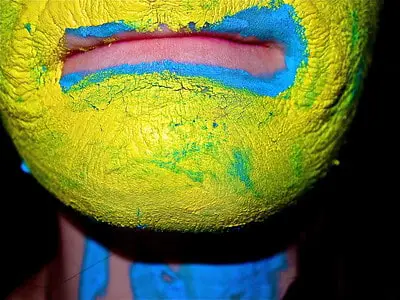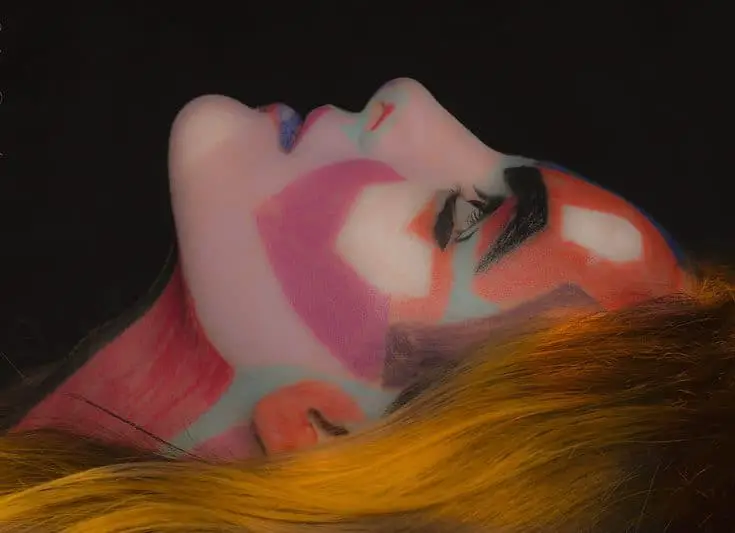Acrylic paint is an affordable and fun paint that many artists use to for their masterpieces, as well as other fun arts & crafts. Since this paint is so versatile, many face painters have now begun to wonder if it can be used as face paint. Acrylic paint is water based, and can be simply removed with water in most cases.
So, can you use acrylic paint as face paint? Technically yes, you can use acrylic paint as face paint, but it’s not highly recommended due to the chemicals and toxins that can be found in the paint.
Even though most acrylic paints are non-toxic, they still have some ingredients that you wouldn’t necessarily want on your face. However, some artists have found ways to turn acrylic paint into a temporary face paint substitute.
Is Acrylic Paint Bad for Your Skin?

Before you consider applying acrylic paint to your skin, it may be worth noting that acrylic paint is not typically recommended to be used a face paint, or on the skin. Mostly because the ingredients in acrylic paint may be toxic, and should be used on other surfaces.
Sometimes, certain paints can be safely used on the skin. In another one of my articles, I talk all about acrylic paint being safe on babies hands, feet and skin. Some people do however decide to use acrylic paint on their face/skin, and they don’t face any side effects.
Whether it’s a cute little design, or for a game night, keep in mind that the paint will dry very fast and it’ll end up quite stiff. When you try to smile, it may also even crack. Think of it like applying a mud face mask. It applies on smoothly, but when it dries, you can barely smile.
If you do decide to use acrylic paint on your face, Arteza is one of my favorite brands. They’re well known, and have a variety of colors to chose from! Also, make sure the brand you chose is non-toxic and can be used on the skin.
Removing Acrylic Paint From Your Face

Regular acrylic paint is typically not recommended to be used on skin due to the compound of the ingredients in it, like lead, formaldehyde, and ammonia. Upon contact with skin, acrylic paint can also be difficult to remove due to its hardening nature.
As such, many artists may be forced to peel the acrylic paint off their skin, (ouch!) and this could cause irritation, redness, or in severe cases pull off some parts of the skin along with the paint.
Luckily, I have found some ways to create face paint using non-toxic acrylic paint. Let’s read below!
How to Turn Acrylic Paint Into Face Paint

Since acrylic paint is so versatile, (yay!) we have found a way to incorporate it into face paint. I recommend that you follow steps below, so you can minimize skin redness, and irritation.
The materials you will need are non-toxic acrylic paint, like this one, a lotion or moisturizer of your choice, and a palette to hold your DIY acrylic face paint. Egg cartons are also recommended if you intend to create various colors.
Once you have prepared the materials, you’ll be ready to turn your acrylic paint into face paint. First, you’ll have to squeeze the non-toxic acrylic paint onto your palette. Then, liberally add the lotion or moisturizer to the color of your choice using a mixing brush, or ice-cream stick until it is well blended.
Using a brush of your choice, pick up some of the paint, and apply it to your face. You may opt to first prime your face with some moisturizing cream, so it forms a slight barrier between your skin and the face paint. keep in mind that the acrylic paint may crack after prolonged exposure to your skin, and may need a touch up after some time.
If you want to directly purchase non-toxic face paints, here are my top picks from Amazon:
Face Paint Kit for Kids – Blue Squid 22 Colors
Face Paint Kit- Imagination Park
How to Remove DIY Acrylic Face Paint?
To remove the DIY acrylic face paint, you’ll have to first rinse your face with soap and water. Because of the way acrylic paint dries, you may find it difficult to remove all the face paint. If washing does not remove the face paint, you may have to peel it off in layers like a facial mask.
I always recommend warm to hot water, and rub the paint in circular motions as if you were taking off a face mask. You can also wet a wash cloth and take the paint off that way, although the cloth material will leave your face a little red. It is pretty much the same thing as removing a face mask or makeup.
Another way to effectively get acrylic paint off your face, is with make-up remover wipes. They work by getting rid of all dirt, debris and junk off your face.
If the DIY face paint burns or feels hot upon application, I recommend immediately removing it, as it may not settle well with your skin. Some people have very sensitive skin, and any harsh chemicals can irritate it. From personal experience, my entire face burned and turned red after applying one of those active charcoal face masks. I had a tomato red face pretty much the rest of the day!
Final Thoughts
Although regular acrylic paint isn’t typically recommend to be applied non your face, a homemade alternative is always better. You can also directly buy a non-toxic face paint kit to save you time. There is a variety of skin-safe face paints that you can purchase, although the colors may be less vibrant than acrylic paints.
If you’d like to experiment with DIY acrylic face paint, you’ll want to be sure to take all preventive steps we discussed above, before using it on your skin. Mixing lotion or moisturizer into the acrylic paints may help neutralize some of the toxic effects from the acrylic face paint, although you may still experience some redness after peeling away the paint.
Don’t forget to read my other articles for all your acrylic painting Q&A’s. Happy painting!


